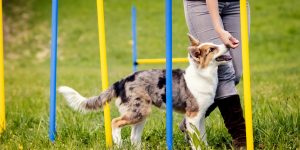Clicker Training – Shaping.
The aim of this exercise is to get your dog to target your hand with a nose touch. This can be useful for more advanced work where you want your dog to ‘follow’ your hand. It can help with loose lead walking, for example, or fun activities such as canine dancing, or agility. Read our Holidays4Dogs article to find out more about clicker training – shaping.
Clicker training is a kind and force-free way of training your pet. If you want to find out more about clicker training basis you can read our other Holidays4Dogs article Exercises such as this provide excellent mental stimulation for dogs of all ages.
It is also fun and interesting for owners to see how their dog interacts by rapidly learning new behaviours. It’s also a simple enough method for children to do and get involved with training the family dog.
To begin – choose a nice quiet place with no distractions. If you have more than one dog, work with just one dog at a time.
-
Begin by offering your hand. If you make a fist shape, this makes it easier for your dog to make contact. If the dog gives any movement towards your hand, click and immediately give a reward from your other hand.
-
This process is termed ‘shaping‘. You are rewarding in small steps, or increments, of the final behaviour you are looking for. You begin by reinforcing a behaviour that is less than what you want, but is similar to it.
-
If your dog goes straight to touching your hand – this is great. Click and treat. Keep repeating. Once you have repeated several times, you can put in a ‘cue’ word, such as ‘touch’. Say this word immediately the dog’s nose comes into contact with your hand.
-
Some dogs, perhaps older dogs new to this type of training, may be slower to react. In this case, you can encourage the dog to go towards your hand by moving your hand. Alternatively, the scent from a treat on your fingers might encourage the dog to move towards your hand. As the dog then reaches out to sniff, click and treat.
Target stick.
Some dogs can become too over excited and too focused on your hands and treats. Therefore, the dog may be impatient to get the treats.
In this case, you could move straight to a ‘target stick‘. These can be bought from pet stores.
However, you can also easily make one yourself by attaching a ping pong ball, or something similar, to a sturdy cane.
In exactly the same way as for hand targeting;
Hold out the stick and wait for any movement of the dog’s nose towards the ball.
Click and treat.
Repeat until the dog moves nearer and nearer and is eventually touching the ball.
Once the dog is reliably nose touching, or ‘targeting’ your hand, or the stick, begin moving the target small distances away. Now the dog has to purposefully move his head – (and eventually his body) – towards it.
Build this up very slowly. You are aiming to move the target to the left, right, higher, or lower, until your dog will consistently touch/follow the target,
Add a cue word.
Remember also to reward each and every time at this stage. Don’t forget – you can start adding the cue word, (touch) – just as the dog’s nose touches the target, so try to be vigilant.
Only when the dog is reliably offering the behaviour can you test whether he has ‘got it’ by saying the cue word (e.g. touch), but without giving any other visual signals. If at any time your dog appears confused, go back a few steps.
Once you have the behaviour under reliable verbal cue, begin to phase out the food reward by sometimes giving a reward and sometimes not. For example, perhaps you might ask for two nose touches before clicking and treating. Similarly, you may wait for three nose touches, then back to one etc, – until eventually you need only reward with food occasionally.
 Behaviours can also be taught by ‘luring’. For example – have a titbit in your hand, just above the dog’s nose and lure him into a sitting position.
Behaviours can also be taught by ‘luring’. For example – have a titbit in your hand, just above the dog’s nose and lure him into a sitting position.
Though luring is just as successful as a clicker training approach, some say a dog is less likely to ‘problem solve’ and can present issues with phasing out the lure.
It is also tempting to end up ‘bribing’, rather than luring. Something which novices can sometimes struggle with.
Shaping, or ‘free shaping’, is more fun for the handler, because although it arguable takes a little longer, it is interesting for the handler to witness the dog, ‘working things out for himself’.
This type of training most definitely keeps dogs interested and uses a good deal of mental energy. Other animals can be taught using the clicker too – horses, goats, rabbits and chickens!
Conclusion.
Once you’ve got the hang of it, clicker training is quick and easy and provides endless entertainment for you and your dog. Ideas for training new and interesting tricks can be found in many clicker training books, or make up your own!
We have many carers who are experienced in positive motivational training, so if you need your dog to practise while you are away, we may be able to help you. Give us a call to find out more.
What tricks have you taught your dogs with this method? Pop over to our Instagram and Facebook pages and tell us more!



